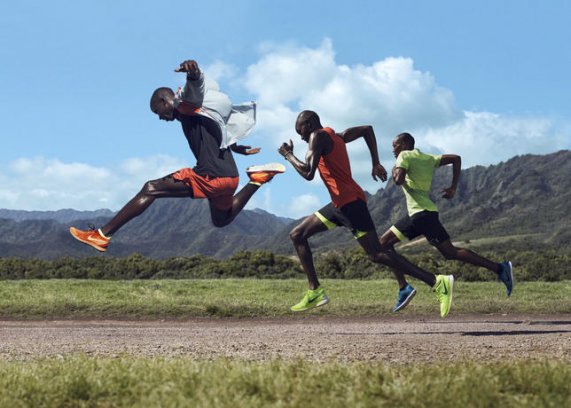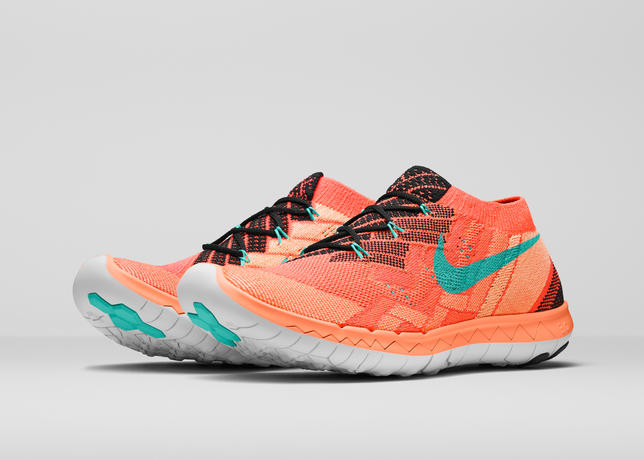
Nike’s first Flyknit apparel innovation
Nike’s flat knitted Flyknit technology debuted in the Flyknit Racer running shoe in the London Olympics in 2012, and has since been utilized in multiple sports.

1st April 2015
Innovation in Textiles
|
Beaverton, OR
Since Nike’s flat knitted Flyknit technology debuted in the Flyknit Racer running shoe in the London Olympics in 2012, the innovative manufacturing process has, according to the company, reduced waste by nearly two million pounds in weight – equivalent to about three times the weight of the world’s largest passenger jet.
After a successful launch in London the Oregon, USA based sportswear giant has since taken the technology into multiple sports including soccer, basketball, running and American football. It has been massively successful in soccer in particular with top players around the world adopting the Flyknit technology boots and the winning goal in last year’s FIFA World Cup final being scored by a German player wearing Flyknit boots.

Nike Flyknit technology doesn’t just erase weight from the shoe; the advanced manufacturing process also reduces waste. While shoe uppers are traditionally constructed from multiple materials cut and sewn together, Nike Flyknit technology knits yarns into a nearly seamless upper to create a lightweight, form-fitting shoe that provides maximum athletic performance with minimal environmental impact.
Flyknit has proved so successful that in the 11th year of the popular Nike Free franchise, Nike has introduced three evolved running styles, two of which incorporate the technology: the Nike Free 3.0 Flyknit, the Nike Free 4.0 Flyknit and the Nike Free 5.0.

According to the company, the new models take the next step toward harnessing the natural motion of a runner’s feet and body – not by adding, but by honing down to the design features that give runners a natural running experience.
The collection features redesigned uppers engineered to work holistically with the shoe’s natural flexibility. The ecosystem offers runners a progression of three natural ride options:
Here’s a look at why less is more with the new Nike Free running collection.

New features can sometimes mean added layers, seams and bulk – issues that often result in friction, more materials and a less flexible, natural fit, Nike says. The Nike Free 3.0 Flyknit and the Nike Free 4.0 Flyknit have virtually seamless one-piece Nike Flyknit uppers that conform to the shape of a runner’s foot and offer support at the same time. Nike Flyknit technology also allows designers to micro-engineer in areas of stretch, support and breathability exactly where runners need it.

The Nike Free 5.0 shed layers this year and now boasts a full bootie construction that delivers seamless comfort and a flexible, lightweight ride. The mesh material used on the upper and the no-sew overlays also contribute to the overall lightness and breathability of the shoe.
All three shoes feature Nike Flywire technology for lightweight, strong support around the midfoot and arch.

“Nike Flyknit technology is a prime example that less can be more and the quintessential upper to complement Nike Free shoes’ natural motion outsoles. The stretchy, featherweight, durable yarn hugs the shape of the foot and simultaneously lends flexibility and support. With a slightly looser weave than in previous models, the Flyknit uppers on the Nike Free 3.0 Flyknit and Free 4.0 Flyknit promote improved breathability,” Nike said in a statement.
While some running shoes benefit from a structured, plastic heel counter on the back of the shoe, the Nike Free 3.0 Flyknit uses Flyknit technology to support the heel. The Nike Free 4.0 Flyknit uses a non-stretch yarn in the heel area to add even more stability and support to those who need it. Removing the structured heel counter frees up the runner’s natural gait and pares down weight.

According to Nike its designers don’t see Nike Free as a shoe made up of individual features. Instead, the company says, they’ve created an ecosystem in which each of the shoe’s attributes work in concert to enable the natural movement of the foot. The form, materials and technology of Nike Free summer footwear harmonize to achieve 360-degree natural motion.

The Nike Free 4.0 Flyknit and Nike Free 5.0 are available through NIKEiD beginning March 23. The full Nike Free ecosystem will be available on nike.com and in stores April 2.

Business intelligence for the fibre, textiles and apparel industries: technologies, innovations, markets, investments, trade policy, sourcing, strategy...
Find out more